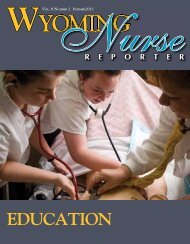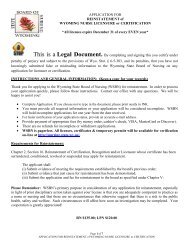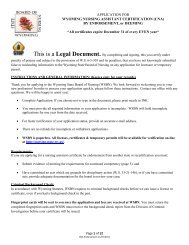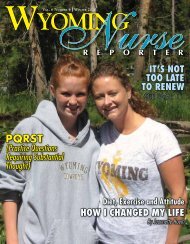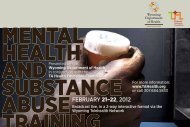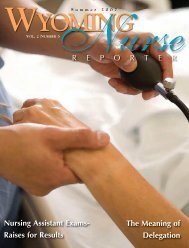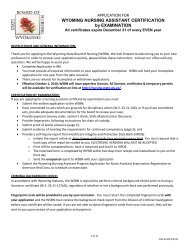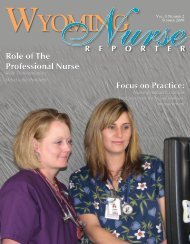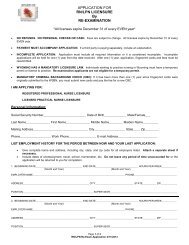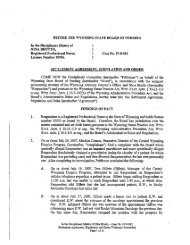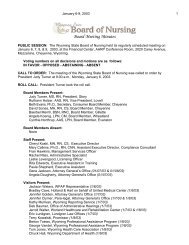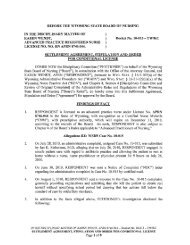Nurse Reporter Spring 2009 - Wyoming State Board of Nursing
Nurse Reporter Spring 2009 - Wyoming State Board of Nursing
Nurse Reporter Spring 2009 - Wyoming State Board of Nursing
Create successful ePaper yourself
Turn your PDF publications into a flip-book with our unique Google optimized e-Paper software.
Continued from previous page<br />
promising patient confidentiality while other criminal<br />
behavior using technology has shown up repeatedly in<br />
discipline cases.<br />
Scientific growth and change, while greatly adding to<br />
the repertoire <strong>of</strong> patient treatment, has also shown up as<br />
a problem for regulatory boards in investigative matters.<br />
The abuse <strong>of</strong> prescription drugs has become a “pharmacoepidemic”<br />
most pronounced in rural states (Hall<br />
et al., 2008) and <strong>Wyoming</strong> is no exception. The WSBN is<br />
researching many complaints involving nurses who divert<br />
and abuse prescription drugs, as well as advanced practice<br />
registered nurses (APRNs) with questionable prescriptive<br />
practices. While substance abuse was certainly<br />
a reality in 1909, the number <strong>of</strong> substances to abuse and<br />
the practices involved in obtaining them to support “a<br />
habit rendering a nurse unsafe to be entrusted with, or<br />
unfit for the care <strong>of</strong> the sick,” has mushroomed. I doubt<br />
that the authors <strong>of</strong> the NPA in 1909 could have considered<br />
what those habits would become in the future. Fortunately,<br />
healthcare pr<strong>of</strong>essions have also grown in our<br />
knowledge about and treatment <strong>of</strong> these “habits.” Today,<br />
addiction and substance abuse are recognized as diagnoses<br />
in the Diagnostic and Statistical Manual <strong>of</strong> Mental<br />
Disorders (American Psychiatric Association, 2000) and<br />
there are many more effective treatments for individuals<br />
with chemical dependence than what may have been<br />
<strong>of</strong>fered in the past. The WSBN continues to work with a<br />
diverse group <strong>of</strong> pr<strong>of</strong>essionals committed to protecting<br />
our citizens and colleagues from the abuse <strong>of</strong> prescription<br />
drugs. WSBN is proud to be a charter member <strong>of</strong> the<br />
Rx Abuse Stakeholders (RAS), a task force initiated by the<br />
<strong>Wyoming</strong> US Attorney, Kelly Rankin.<br />
The mission <strong>of</strong> the WSBN has not changed much in<br />
the past 100 years: to serve and safeguard the people <strong>of</strong><br />
<strong>Wyoming</strong> through the regulation <strong>of</strong> nursing education and<br />
practice. The language <strong>of</strong> the NPA and its interpretation<br />
is continually brought under scrutiny as we work to fulfill<br />
our obligation to protect the public from practitioners<br />
who violate those standards. When the board revised its<br />
mission statement this past year, there was discussion on<br />
which order to place the words “education” and “practice.”<br />
It was decided that since practice cannot take place<br />
before education, the word “education” would come first.<br />
The NPA <strong>of</strong> 1909 reads:<br />
…nurses…who at the time <strong>of</strong> application shall have<br />
graduated from a training school, connected with a general<br />
hospital, registered by said examining board and requiring<br />
a systematic course <strong>of</strong> at least two years training;<br />
provided such applicants shall pass an examination to be<br />
prescribed by said board, to determine their fitness and<br />
ability to give efficient care to the sick (NPA, 1909, p. 88-<br />
89).<br />
Surprisingly, the length <strong>of</strong> educational time required<br />
<strong>of</strong> registered nurses has not changed as much in the past<br />
100 years as it has for other healthcare pr<strong>of</strong>essions. According<br />
to the National Sample Survey <strong>of</strong> Registered <strong>Nurse</strong>s<br />
(2000), from 1980 to 2000, the percentage <strong>of</strong> nurses receiving<br />
their basic education in diploma programs (three<br />
years) decreased from 60 percent to 30 percent, and the<br />
percentage completing associate degree programs (two<br />
years) increased from 19 percent to 40 percent (Spratley,<br />
Johnson, Sochalski, Fritz, & Spencer, 2000). The National<br />
Council <strong>of</strong> <strong>State</strong> <strong>Board</strong>s <strong>of</strong> <strong>Nursing</strong> reports that associate<br />
degree nurses comprise approximately 60 percent <strong>of</strong> today’s<br />
RN workforce (N. Spector, personal communication<br />
February 13, <strong>2009</strong>). This is in contrast to physician education.<br />
In the same 100-year period, medical education<br />
evolved from four year university programs or apprenticeships<br />
to the current minimum eight years plus residency<br />
(usually three to five years), and <strong>of</strong>ten a fellowship with<br />
additional years <strong>of</strong> specialty training. Our healthcare colleagues<br />
in pharmacy have moved to doctoral preparation<br />
(seven years) for entry level, physical and occupational<br />
therapy and mental health pr<strong>of</strong>essionals require a master’s<br />
degree (six years) for entry level; most are moving<br />
toward doctoral preparation. The nursing pr<strong>of</strong>ession is<br />
currently rolling out a doctor <strong>of</strong> nursing practice (DNP)<br />
(approximately eight years total) that is receiving significant<br />
attention. As we look back on our history and how<br />
we have grown as a pr<strong>of</strong>ession in the past 100 years, it is<br />
worth asking ourselves whether entry level educational<br />
requirements should be re-examined.<br />
It is certainly true that the context <strong>of</strong> nursing education<br />
has radically changed from the hospital-based training<br />
programs alluded to in the 1909 NPA. Today’s nursing<br />
education is delivered in community college and university<br />
classrooms, hospitals, clinics, simulation laboratories<br />
and via laptop computers to students who may be located<br />
literally anywhere in the world! Very importantly, today’s<br />
nurse is educated to be at least as concerned about the<br />
“wellness” <strong>of</strong> the patient (who may be a family or a community)<br />
as the “illness or infirmity” <strong>of</strong> the patient.<br />
Just as the authors <strong>of</strong> that 1909 NPA could not envision<br />
what nursing in <strong>Wyoming</strong> would look like today, we<br />
cannot foretell what future generations <strong>of</strong> nurses will<br />
say (and laugh!) about the pr<strong>of</strong>ession’s trajectory when<br />
they next celebrate the WSBN’s centennial in 2109. However,<br />
we have experienced enough change and growth in<br />
our current world to know that it will exceed our wildest<br />
dreams. Imagine the progress there will be in technology,<br />
communication and travel, much less in curing and<br />
preventing diseases! It is still my most fervent hope and<br />
dream that despite any and all technological advances,<br />
the elements <strong>of</strong> caring, compassion and trustworthiness<br />
remain the foundation <strong>of</strong> the nursing pr<strong>of</strong>ession.<br />
References<br />
American Psychiatric Association. (2000). Diagnostic<br />
and statistical manual <strong>of</strong> mental disorders. Arlington, VA:<br />
American Psychiatric Publishing, Inc.<br />
Gallup. (2007). <strong>Nurse</strong>s top for ethics and honesty. Retrieved<br />
June 15, 2008, June 15, 2008, from http://www.gallup.com/video/103117/<strong>Nurse</strong>s-Top-Ethics-Honesty.aspx<br />
Hall, A. J., Logan, J. E., Toblin, R. L., Kaplan, J. A., Kraner,<br />
J. C., Bixler, D., et al. (2008). Patterns <strong>of</strong> abuse among<br />
unintentional pharmaceutical overdose fatalities. Journal<br />
<strong>of</strong> the American Medical Association, 300(22), 2613-2620.<br />
Spratley, E., Johnson, A., Sochalski, J., Fritz, M., &<br />
Spencer, W. (2000). The Registered <strong>Nurse</strong> population,<br />
March, 2000: Findings from the national sample survey <strong>of</strong><br />
Registered <strong>Nurse</strong>s. (H. R. a. S. Administration o. Document<br />
Number)<br />
Thank you for the excellent editorial and<br />
follow-up article on caring. The article was excellent!<br />
I shared it with the nursing staff here<br />
along with a note on how fortunate I am to<br />
work with nurses who truly care. Thank you.<br />
Pat Weber RN, MSN NHA<br />
<strong>Nursing</strong> Home Administrator<br />
St. John’s Medical Center<br />
Jackson, WY 83001<br />
Dear <strong>State</strong> <strong>Board</strong> <strong>of</strong> <strong>Nursing</strong>:<br />
Just finished reading my <strong>Wyoming</strong> <strong>Nurse</strong><br />
<strong>Reporter</strong> and wanted to thank you for publishing<br />
and sending it to the nurses <strong>of</strong> <strong>Wyoming</strong>.<br />
Reading it has been educational and answered<br />
4 Wy o m i n g Nu r s e Re p o r t e r<br />
many questions for me. Good to know, also,<br />
that I am not alone in some issues that challenge<br />
me. I feel the “reporter” is just the right<br />
length and comes at just the right frequency.<br />
Thank you for your service to us by being on<br />
the state board, your work on our behalf is appreciated.<br />
Sincerely, Julie Stott, RN<br />
Congratulations on the great article you<br />
had published in the <strong>Wyoming</strong> <strong>Nurse</strong> <strong>Reporter</strong>.<br />
I enjoyed reading it and really felt like you<br />
got to the core <strong>of</strong> nursing. Anyone can start<br />
IVs, hang blood, etc...., but it is absolutely the<br />
role <strong>of</strong> the nurse to anticipate and care for the<br />
family and the dying individual (even after an<br />
attempted suicide) as Mary Kay Goetter described.<br />
In fact, it seems to me that if a nurse<br />
did not attempt to care for them, that this<br />
would almost constitute negligence! Unfortunately,<br />
I <strong>of</strong>ten hear <strong>of</strong> nurses who simply focus<br />
on the task at hand and don’t try to assess and<br />
plan for the whole situation.<br />
Thank you so much for taking the time to<br />
share and write your story.<br />
Ann Marie Hart, PhD, FNP<br />
Assistant Pr<strong>of</strong>essor<br />
NP Program Coordinator<br />
University <strong>of</strong> <strong>Wyoming</strong><br />
Fay W. Whitney School <strong>of</strong> <strong>Nursing</strong>



